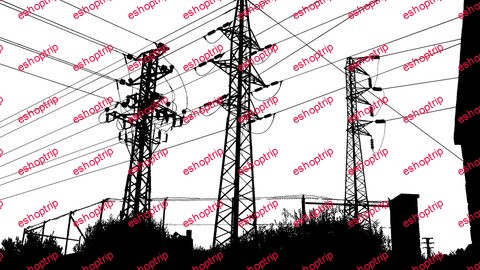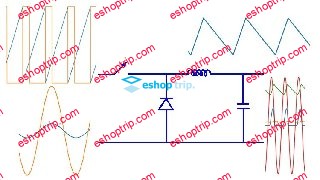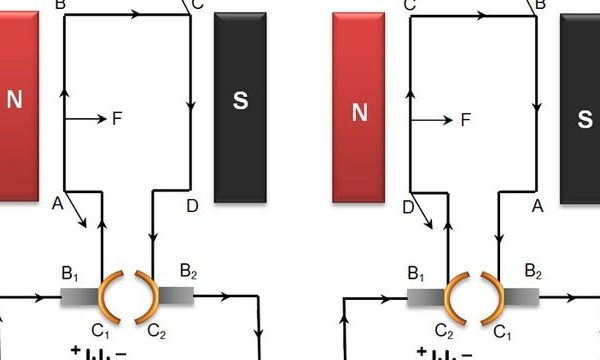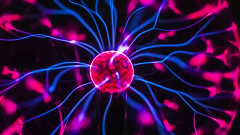Published 3/2023
MP4 | Video: h264, 1280×720 | Audio: AAC, 44.1 KHz
Language: English | Size: 8.46 GB | Duration: 21h 37m
Your complete guide in power system analysis, modelling, load flow and fault studies, for electrical power engineering
What you’ll learn
Realize the structure of the electric power sysyem
Learn how to draw single line diagram of any power system
Review of basic electrical concepts
Different types of powers in power system
Realize power factor correction
Complete analysis of three phase power systems
Difference between delta and star three phase supply and load
Learn power calculations in three phase systems
Power factor correction in three phase systems
Generators in power systems
Salient pole vs. cylindrical rotor generators
Generator operation and its equivalent model in power system
Learn how to assess the performance parameters of synchronous generators
Realize generator characterstics and its phasor diagram
Relaize the operation and construction of transformers in power systems
Learn how to model a transformer in power systems
Learn how to measure the transformer parameters
Realize three phase transformer connections and their applications
Transmission lines in power systems
Realize the modelling and performance of transmission lines
Complete analysis of short, medium, and long line models
Relaize the surge impedance loading (SIL) and its importance
Realize the per-unit system and its use in analyzing power systems
Change of Base in per unit system
Concept and importance of power flow analysis
Formation of bus admittance matrix and its importance in load flow analysis
Understand types of buses in power system
Learn how to obtain load flow equations
Realize approximate method in power flow analysis
Learn Gauss-Seidal method in power flow analysis
Learn DC power flow method in power flow analysis
Learn how to evaluate the losses and power flow in transmission lines
Complete analysis of power system faults
Realize definition, causes, and consequences of electric faults
analyze the symmetrical faults using thevenin method
analyze the symmetrical faults using bus impedance matrix
Learn how to construct bus impedance matrix
Realize the concept and formulation of symmetrical components method
Learn how to get the sequence networks for generators, transformers, and transmission lines
Analysis of (L-G), (L-L), and (L-L-G) faults
Many MATLAB projects related to power systems
Requirements
Electrical engineering fundamentals
Passion to learn power system engineering
Description
Hi and welcome everyone to our course “Ultimate Electrical Power System Engineering Masterclass”In this course, you are going to learn everything about power system analysis starting from the power system basics and fundamentals of single phase and three phase electric systems moving to designing and modelling different power system components such as: generators, transformers, and transmission lines, ending with a complete power system studies such as load flow studies and power system faults analysis. Thus, this course will be your complete guide in one of the main areas of power engineering: ( power system analysis )The course is structured as follows:Firstly, an overview on the power system structure is illustrated through the following topics:Generation, transmission, distribution, and consumption of electric powerHow to draw a single line diagram (SLD) of any power systemThen, the next topic will be about a review on basic electrical engineering concepts to be a quick refresh for you. The following topics will be covered:Different types of powers in power systemComplex power, power triangle, and power factor definitionspower factor correction Complex power flow in any power systemThen, a complete study of three phase systems is introduced since 99% of practical electric networks are actually three phase systems. Thus, three phase circuits are explained in depth through the following topics:Why we need three phase systems?Three phase supply and load Different 3-ph connections (star-star), (star-delta), (delta-star), (delta-delta) Difference between (3-wire) and (4-wire) 3-ph systemsThe relations between line and phase currents and voltagesPower analysis in 3-ph systemsPower factor improvement in 3-ph circuitsThen, you are going to learn the modelling and characteristics of generators in power systems starting from the operation and construction of alternators moving to measuring the performance indices of synchronous generators. The following topics will be covered:Construction and operation of alternatorsSalient pole vs. Cylindrical rotor generatorsGenerator model in power systemsGenerator phasor diagram and characteristicsGenerator performance parametersPower angle curve of synchronous generatorsThe next topic is about transformers and their use in power systems. We are going to discuss how the transformers work and their importance in power systems through the following outlines:Construction and operation of transformersTransformer equivalent circuitTests performed on transformersTransformer efficiency and regulationThree-phase transformer types and connectionsPer phase model of three phase transformerAfter that, we are going to a complete modelling of different types of transmission lines with assessing the transmission line performance in electric networks through the following topics:Overhead lines vs. Under ground cables (UGC)Transmission line modelling and performanceShort, medium, and long line modelsLossless transmission linesSurge impedance loading (SIL)Now, after modelling and analyzing different power system components, lets move to the per unit system and learn the concept and importance of per unit in power system analysis through the following outlines:Concept of per unitPer unit calculationsHow to draw per unit reactance diagramChange of baseNumerical examples on practical power systemsThen, we are going to a complete power flow analysis where we are going to know the electrical parameters for any power system under any operating conditions. The following topics are discussedConcept and importance of power flow studyDefinitions in power flow analysisTypes of power system busesFormation of YbusApproximate methodIterative methods for load flow analysisGauss-Seidal methodPower flows and losses analysisDC power flow methodNumerical examples on practical power systemsThen, a complete fault analysis is performed on power systems to find the fault current, bus voltages and line current during the fault. All these outlines are discussedDefinition, causes, types, and consequences of electric faultsComplete symmetrical fault analysis using thevenin and ZbusSymmetrical components and sequence networksComplete unsymmetrical fault analysis using thevenin and ZbusFinally, after the complete analysis of power system, practical projects are performed on MATLAB related to power systems as follows :Project 1 – Stand alone synchronous GeneratorProject 2 – Synchronous Generator connected to the gridProject 3 – Simulation of 3-ph transformersProject 4 – Transmission line designProject 5 – Power flow study in MATLABProject 6 – Fault analysis in MATLABSo, if you are Looking for a COMPREHENSIVE course about Electrical power system analysis engineering for power system modelling, design and analysis ? If your answer is YES, then you’re definitely in the right place.
Overview
Section 1: Electric Power System Overview
Lecture 1 Generation and transmission of electric power
Lecture 2 Distribution and consumption of electric power
Lecture 3 E-Book of The Course
Lecture 4 Single line diagram (SLD) of power system
Section 2: Review of Basic Principles
Lecture 5 Different types of power in power system
Lecture 6 Complex power and power triangle
Lecture 7 Example 1- Power analysis
Lecture 8 Power factor Definition
Lecture 9 Power factor correction
Lecture 10 Example 2- power factor correction
Lecture 11 Complex Power Flow
Lecture 12 Example 3- Power flow in power systems
Section 3: Balanced Three-Phase Systems
Lecture 13 Advantages of 3-phase in power system
Lecture 14 Balanced 3-phase supply
Lecture 15 3-phase circuit connections
Lecture 16 Line and phase voltages in star loads
Lecture 17 Star-Star system (4-wire)
Lecture 18 Star-Star system (3-wire)
Lecture 19 Example 1 – (star-star)
Lecture 20 line and phase currents in delta loads
Lecture 21 Star-Delta system
Lecture 22 Example 2- (star-delta)
Lecture 23 Delta-Star system
Lecture 24 Example 3- (delta-star)
Lecture 25 Delta-Delta system
Lecture 26 Example 4- (delta-delta)
Lecture 27 3-phase instantenous Power
Lecture 28 Power in balanced 3-ph system
Lecture 29 Power factor improvement in 3-ph circuits
Lecture 30 Example 5- PF correction in 3-ph systems
Section 4: Generators in Power System
Lecture 31 Synchronous generators (Alternators)
Lecture 32 Salient pole vs. cylindrical rotor generators
Lecture 33 Alternator operation
Lecture 34 Induced EMF Equation
Lecture 35 Magnetization curve of synchronous generators
Lecture 36 Generator model (equivalent circuit)
Lecture 37 Phasor diagram of synchronous generators
Lecture 38 Performance parameters of synchronous generator
Lecture 39 Power angle characteristics of Synchronous generator
Lecture 40 Example 1 – Generator model
Lecture 41 Example 2 – Performance parameters of alternators
Section 5: Transformers in power systems
Lecture 42 Transformer construction and operation
Lecture 43 Transformer equivalent circuit
Lecture 44 Example 1 – Transformer circuit model
Lecture 45 No load test of transformers
Lecture 46 Short circuit test of transformers
Lecture 47 Example 2 – Determination of transformer parameters
Lecture 48 Transformer Performance
Lecture 49 Three-Phase Transformers
Lecture 50 Three phase transformer Connections
Lecture 51 Per-Phase Model of 3-Phase Transformer
Lecture 52 Example 3 – Three-phase Transformer efficiency
Section 6: Transmission Lines in Power Systems
Lecture 53 Introduction to Transmission Lines
Lecture 54 Transmission line Parameters
Lecture 55 Transmission Line Modelling and Performance
Lecture 56 Short Transmission Line
Lecture 57 Example 1 – Short line model
Lecture 58 Medium Transmission Line
Lecture 59 Example 2 – Medium line model
Lecture 60 Long Transmission Line
Lecture 61 Equivalent PI- Model
Lecture 62 Lossles Transmission lines
Lecture 63 Surge Impedance Loading (SIL)
Lecture 64 Example 3 – Long line model & SIL
Section 7: Per Unit System
Lecture 65 Concept of Per Unit System
Lecture 66 Per Unit Calculations
Lecture 67 Solved Example 1 – P.U calculations
Lecture 68 Change of Base
Lecture 69 Complete numerical example on P.U system – part 1
Lecture 70 Complete numerical example on P.U system – part 2
Section 8: Power Flow analysis
Lecture 71 Concept and importance
Lecture 72 Important definitions related to load flow study
Lecture 73 Types of buses in power system
Lecture 74 Bus admittance matrix (Ybus)
Lecture 75 Example 1 – Ybus formation
Lecture 76 Load flow equations
Section 9: Load Flow Solution Methods
Lecture 77 Approximate method
Lecture 78 Example 1 – Approximate method
Lecture 79 Gauss-Seidal method
Lecture 80 Example 2 – Gauss-Seidal (Part 1)
Lecture 81 Example 2 – Gauss-Seidal (Part 2)
Lecture 82 Line flows and losses
Lecture 83 Example 3 – Line flows and losses
Lecture 84 DC power flow method
Lecture 85 Mathematical formulation of DC power flow
Lecture 86 Example 4 – DC power flow
Section 10: Fault Analysis in Power System
Lecture 87 Fault Analysis: Overview
Lecture 88 Causes of faults
Lecture 89 Faults in power system in a year
Lecture 90 Types of power system faults
Lecture 91 Consequences of faults
Lecture 92 Assumptions in fault studies
Section 11: Symmetrical Faults Analysis
Lecture 93 Synchronous generator reactance under short circuits
Lecture 94 Symmetrical fault analysis using Thevenin
Lecture 95 Example 1 – Fault analysis using Thevenin
Lecture 96 Symmetrical fault analysis using bus impedance matrix
Lecture 97 Example 2 – Fault analysis using bus impedance matrix (Zbus)
Lecture 98 Bus impedance matrix building algorithm
Lecture 99 Example 3 – Zbus formation
Section 12: Symmetrical Components and Sequence Networks
Lecture 100 Concept of symmetrical components
Lecture 101 Formulation of symmetrical components
Lecture 102 Important notes
Lecture 103 Numerical examples on symmetrical components
Lecture 104 Sequence networks
Lecture 105 Sequence networks for generator and transmission lines
Lecture 106 Sequence networks for transformer
Lecture 107 Example 1 : (+, -, 0) sequence networks for a given power system
Lecture 108 Example 2 : (+, -, 0) sequence networks for a given power system
Section 13: Unsymmetrical Faults analysis
Lecture 109 Overview and objective
Lecture 110 L-G fault analysis
Lecture 111 L-L fault analysis
Lecture 112 L-L-G fault analysis
Lecture 113 Summary and steps of solution
Lecture 114 Solved example on unsymmetrical faults – part 1
Lecture 115 Solved example on unsymmetrical faults – part 2
Section 14: Practical Projects – Power Systems Simulations in MATLAB
Lecture 116 Project 1 – Stand alone synchronous Generator
Lecture 117 Project 2 – Synchronous Generator connected to the grid
Lecture 118 Project 3 – Simulation of 3-ph transformers
Lecture 119 Project 4 – Transmission line design
Lecture 120 Project 5 – Power flow study in MATLAB
Lecture 121 Project 6 – Fault analysis in MATLAB
Any one having the passion to learn power system engineering from scratch,Electrical power engineers with an interest in power system analysis
HOMEPAGE
https://anonymz.com/?https://www.udemy.com/course/ultimate-electrical-power-system-engineering-masterclass/











Reviews
There are no reviews yet.